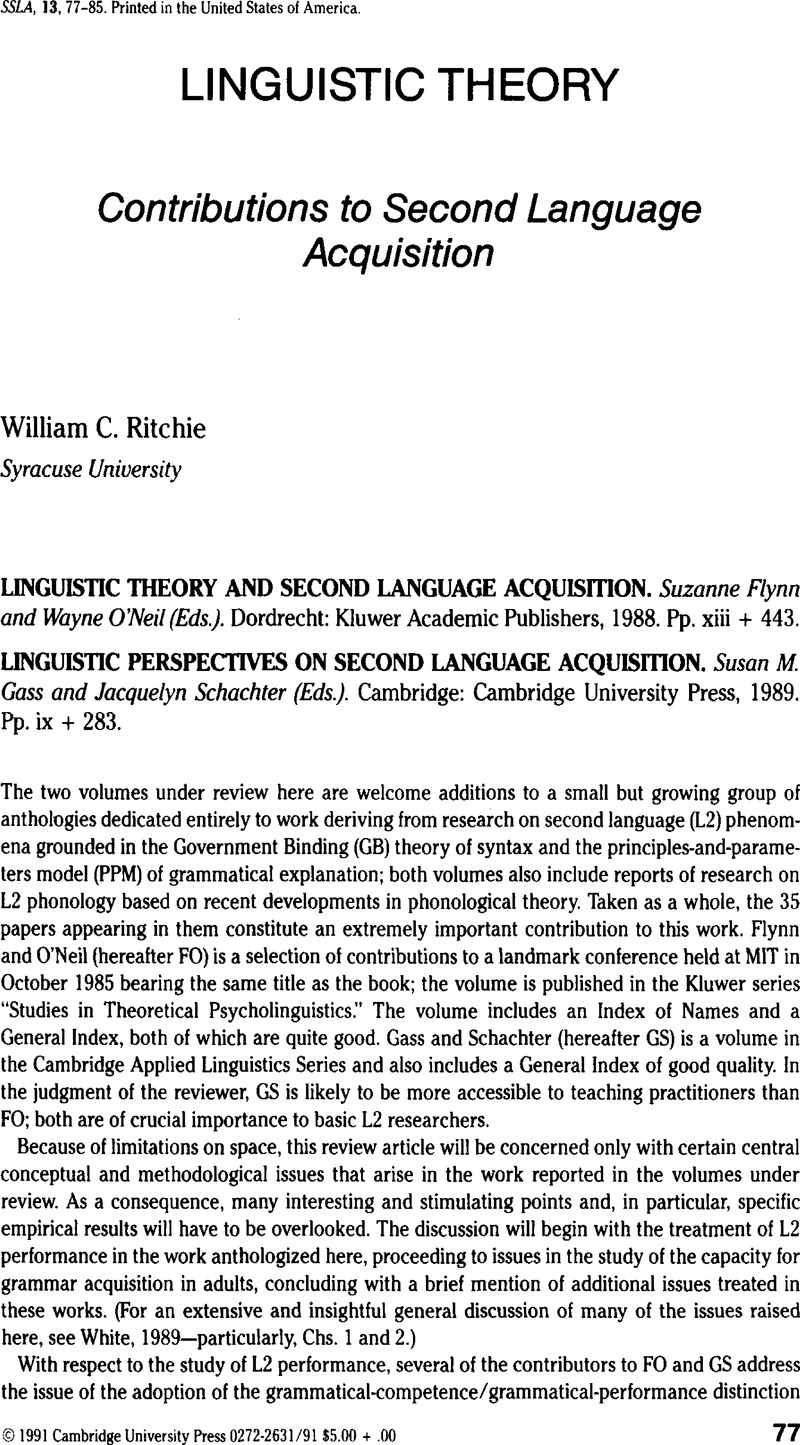No CrossRef data available.
Article contents
Linguistic Theory
Contributions to Second Language Acquisition
Published online by Cambridge University Press: 07 November 2008
Abstract
An abstract is not available for this content so a preview has been provided. Please use the Get access link above for information on how to access this content.

- Type
- Review Article
- Information
- Copyright
- Copyright © Cambridge University Press 1991
References
Bates, E., & MacWhinney, B. (1981). Second language acquisition from a functionalist perspective: Pragmatic, semantic, and perceptual strategies. In Winitz, H. (Ed.), Annals of the New York Academy of Sciences conference on native and foreign language acquisition (pp. 192–214). New York: New York Academy of Sciences.Google Scholar
Berwick, R. (1985). The acquisition of syntactic knowledge. Cambridge, MA: MIT Press.CrossRefGoogle Scholar
Borer, H., & Wexler, K. (1987). The maturation of syntax. In Roeper, T. & Williams, E. (Eds.), Parameter setting (pp. 123–172). Dordrecht: D. Reidel.CrossRefGoogle Scholar
Cinque, G. (1981). On Keenan and Comrie's Primary Relativization Constraint. Linguistic Inquiry, 12, 293–308.Google Scholar
Clahsen, H. (1984). The acquisition of German word order: A test case for cognitive approaches to second language development. In Andersen, R. (Ed.), Second languages (pp. 219–242). Rowley, MA: Newbury House.Google Scholar
Clahsen, H., & Muysken, P. (1986). The availability of universal grammar to adult and child learners: A study of the acquisition of German word order. Second Language Research, 2, 93–119.Google Scholar
Clahsen, H., & Muysken, P. (1989). The UG Paradox in L2 acquisition. Second language research, 5, 1–29.Google Scholar
duPlessis, J., Solin, D., Travis, L., & White, L. (1987). UG or not UG, that is the question: A reply to Clahsen and Muysken. Second Language Research, 3, 56–75.Google Scholar
Flynn, S. (1983). A study of the effects of principle branching direction in second language acquisition: The generalization of a parameter of universal grammar from first to second language acquisition. Unpublished PhD dissertation, Cornell University, Ithaca, NY.Google Scholar
Huang, C.-T. J. (1984). On the distribution and reference of empty pronouns. Linguistic Inquiry, 15, 531–574.Google Scholar
Hyams, N. (1986). Language acquisition and the theory of parameters. Dordrecht: Reidel.CrossRefGoogle Scholar
Hyltenstam, K. (1984). The use of typological markedness conditions as predictors of second language acquisition: The case of pronominal copies in relative clauses. In Andersen, R. (Ed.), Second languages (pp. 39–58). Rowley, MA: Newbury House.Google Scholar
Keenan, E., & Comrie, B. (1977). Noun phrase accessibility and universal grammar. Linguistic Inquiry, 8, 63–99.Google Scholar
Martohardjono, G., & Gair, J. (1989, April). Apparent UG inaccessibility in SLA: Misapplied principles or principled misapplications. Paper delivered at the 1989 UWM Colloquium on Linguistics, Milwaukee, Wisconsin.Google Scholar
Tarone, E. (1984). On the variability of interlanguage systems. In Eckman, F., Bell, L., & Nelson, D. (Eds.), Universals of second language acquisition (pp. 3–23). Rowley, MA: Newbury House.Google Scholar
White, L. (1986). Markedness and parameter setting: Some implications for adult second language acquisition. In Eckman, F., Moravcsik, E., & Wirth, J. (Eds.), Markedness (pp. 309–327). New York: Plenum.CrossRefGoogle Scholar
White, L. (1989). Universal Grammar and second language acquisition. Amsterdam: John Benjamins.CrossRefGoogle Scholar


